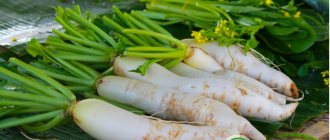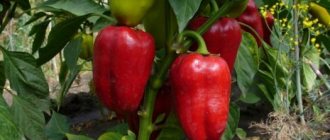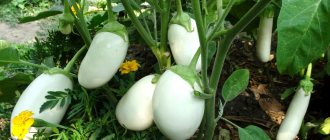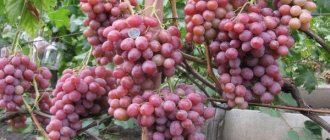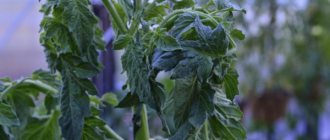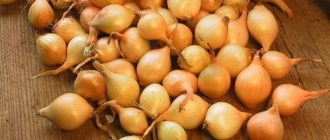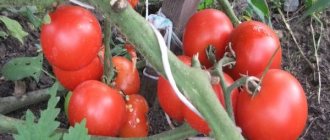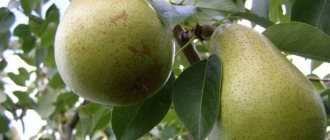Gardeners are increasingly occupying the beds with daikon Sasha. This Japanese radish attracts with its taste and yield. It is distinguished from black by increased juiciness and lack of bitterness. Root crops grow large. From one ridge, summer residents receive a large harvest.
In Japan, scientists conducted a study of daikon. Planted on land contaminated by radiation, the root crop remained free of isotopes. Radish does not accumulate nitrates.
Sasha is a product of Russian breeders. It is suitable for growing in temperate climates. On one ridge you can grow 2 crops per season.
Characteristics and description of the variety
The Sasha variety is a godsend for gardeners. It differs from its Japanese counterparts in its ability to produce crops in almost any climate zone.
Radish was created by VNIISSOK agronomists. Named after Alexandra Agapov. Description of the variety:
- representative of the Cruciferous family;
- root crop is round in shape, slightly elongated, with a “tail”;
- color white, with slight yellowness;
- the pulp is juicy, aromatic;
- consistency is dense, elastic;
- the taste is sweet-spicy;
- the skin is dense;
- protrudes above the soil surface by 1/3;
- radish weight from 200 to 400 g.
The root crop is easy to pull out of the ground: just pull and twist the tops a little . This is convenient: the crop is not damaged during harvesting.
The characteristics of radish resemble a list of advantages:
- The variety is early ripening: ripens 35-40 days after germination.
- It is resistant to bacteriosis.
- Does not throw out flower stalks (if agricultural practices are followed).
- Produces harvest uniformly and evenly.
- It has a pleasant taste: the bitterness is almost not felt.
- Root crops are aligned.
- The culture is cold-resistant.
- Convenient to use: the small size allows you to consume the radish whole.
- Thick skin provides excellent transportability.
Gardeners are put off by their low shelf life: after a month, root crops shrivel and lose their juiciness.
Advantages and disadvantages
Summer residents who have practiced growing daikon Sasha on their plots are very pleased with the harvest. In particular, they note the following positive aspects of the variety:
- first of all, ultra-early ripening, which allows you to enjoy the root crop literally a month after sowing the seeds;
- unpretentiousness to soil conditions and composition;
- the ability to grow crops all year round (in the garden and in greenhouses);
- ease of care;
- low shooting ability;
- excellent taste and can be used in dietary and children’s diets;
- good preservation qualities (up to 3 months), which is rare for summer varieties.
The Sasha variety has no serious disadvantages. A minor drawback is the tendency of root crops to crack, but this is rather a problem of improper care.
Seed selection
Gardeners should carefully select planting material. When planting in small beds, it is recommended to buy seeds from trusted producers. Their products undergo soil control. There is no need to prepare the seeds for sowing.
Some gardeners strive to use their own planting material. To do this, you should sow Sasha early: together with radishes. The radish will give the shooter. It should be tied to a peg, and the pods should be covered with gauze (to prevent premature rash). Then thresh the mature beans and keep them in a paper bag in a dry, dark place. When properly stored, the seeds have a germination period of 8 years .
See also
How and when to plant, grow and care for radishes in open groundRead
Such material must be prepared for planting: checked for germination, disinfected, stimulated. It takes quite a long time.
Useful properties of Daikon
Daikon is a dietary product. 300 g of fresh vegetables provides the daily requirement for vitamin C. Rich in vitamins “B”, “A”, “E”, “K”, “D”. Among chemical substances, it contains increased amounts of potassium, calcium, phosphorus, magnesium, iron and other macro- and microelements. Daikon root vegetables contain isorodanoic acid ester, which inhibits the processes of cancer. Young leaves of root vegetables are used in vitamin salads (the content of vitamin C is 6 times higher than in root vegetables).
In terms of the number of beneficial properties, daikon deserves to take first place among vegetable crops. It is extremely useful for its low calorie content and a quick feeling of fullness. Daikon is rich in fiber, which cleanses the intestines, liver and other organs well. At home, it is widely used in the treatment of acute respiratory infections and infectious diseases. Increases immunity.
The root vegetable helps remove cholesterol from the body and has a therapeutic effect in atherosclerosis, diabetes, and radiation damage. Daikon juice and gruel cleanse the skin well of acne and freckles, strengthen hair roots in case of increased hair loss, reduce nervous excitability, and eliminate insomnia. Root vegetable gruel replaces kvass for severe hangovers.
Selecting a site for planting
To place the daikon you need to choose a well-lit area. The soil should be loose, air and moisture permeable. The bed should be fertilized before planting. On poor soils, radish produces small root vegetables with coarse pulp.
Sasha does not tolerate stagnant water, but loves moist areas. The gardener is advised to think about the predecessors of radish. The best are tomatoes, onions, garlic, beans, peas. It is not recommended to plant Sasha after radishes, turnips, cabbage, and radishes.
Root vegetable of health and longevity
Translated from Japanese, “daikon” means “big root.” It was developed by the Japanese from the Chinese loba radish. Then the vegetable settled on the private plantations of peasants. Daikon has been made a symbol of health, strength and prosperity. Dances with radish roots and even their free distribution at many public events in the autumn season have been introduced into the country's culture.
A size of 1.5 meters for daikon is not uncommon in Japan
But the advancement of the vegetable to the west was difficult. It took almost 20 centuries for sweet radish to finally appear on the tables of Europeans. As a result, the unusual root vegetable was tasted and appreciated. Similar to radish, but unlike it, the sweet-tasting vegetable was so amenable to selective breeding, genetic modification and hybridization that by the first decade of the 21st century there were already about 500 varieties of daikon. They differed from each other in the density of the fibers, and in the degree of piquancy, and in the brightness of taste, but especially in their shape: there were simple balls, and serpentine arrows, and spindle-shaped spirals, and icicles of an incomparable milky-white color.
But all varieties were united by one essential quality - the absence of pungent mustard oils, which have a stimulating effect on the heart muscle and are characteristic of radishes and radishes. Daikon, as it turned out, surpassed its relatives not only in taste, but also in the content of microelements that inhibit the growth of pathogenic intestinal microflora and have a beneficial effect on the functioning of the liver and kidneys.
Daikon - a treasure trove of vitamins and microelements
Landing dates
Sasha's precocity allows him to be planted twice a season. It is recommended to do the first planting in the spring, after the soil has warmed to 4 degrees. The second stage occurs after daylight hours begin to decrease. Usually this is July-August.
When sowing in the same area, it is recommended to plant green manure after harvesting the first crop. White mustard grows quickly. It will restore fertility and loosen the soil. After the tops grow by 10 cm, the greens are embedded in the soil when digging.
For each area, planting dates are determined individually. The gardener must take into account:
- short daylight hours (the radish will not produce a flower stalk);
- a slight difference between day and night temperatures (you will get juicy, tender pulp).
Compliance with planting dates will provide the gardener with marketable root crops and save the plants from being damaged by the cruciferous flea beetle.
Features of cultivation
Planting and caring for daikon is not labor intensive. It can grow in any soil, but shows best productivity in light, albeit not very fertile, soils. If the soil is heavy and clayey, you need to dig it up and add some organic matter (compost, humus). Vegetables grown in such soil will have a richer taste.
Most daikon varieties are recommended to be sown in the second half of summer, but this does not apply to the “Sasha” variety. When to plant daikon of this variety, you can decide for yourself, based on your desires. Given the very short growing season, the crop can be sown in the spring, at the same time as radishes, in the second half of summer or at the end of August. Whatever planting time you determine, the root crops will still have time to ripen, because for this they need only 1 month. Winter growing root vegetables in a greenhouse takes a little longer.
Fresh daikon seeds germinate very quickly - after 4-7 days, depending on soil moisture.
They are sown in furrows at a distance of 60–70 cm between rows. Despite the fact that the root crops themselves are not very large, their tops are large, and if the rows are placed more densely, the grown plants will interfere with each other. The seeds are not sown densely, since most of the sprouts will be removed during thinning; they are buried by more than 1.5–2 cm.
Crop care consists of the following processes:
- thinning (performed as soon as 2–3 true leaves are formed on the plants). It is necessary to leave the strongest shoots at a distance of 20–25 cm from each other;
- watering Until the seeds hatch, the soil must be kept moist, then the daikon is watered as the top layer of soil dries;
- weeding (2–3 times);
- protection from pests.
Protection from harmful insects, in particular from the cruciferous flea beetle, is a separate topic in daikon agricultural technology. Resistant to many diseases and parasites, it is completely defenseless against the flea beetle, for which young tender leaves are a real delicacy.
To protect crops from flea beetles, some gardeners spray them with a liquid mixture (tobacco, ash, red pepper). But this method does not always give results. Then the problem is solved more simply - until the first true leaf appears, daikon is grown under cover (film, spunbond). In this way, several problems are solved: the plants are protected from flea beetles, and the soil is protected from drying out and weed growth.
It is recommended to apply fertilizers to the soil only before planting.
During the growing season, you should not feed daikon, as root vegetables quickly accumulate chemicals. The harvest is harvested immediately after ripening. If you keep it in the ground, the flesh may become tough and the taste will deteriorate. For storage, daikon is dried, placed in a cool place or covered with sand. In this form it can be stored for up to 3 months.
Rules for caring for daikon
Breeders promise high yields only if agricultural practices are followed. Gardeners are recommended to follow the advice of agronomists.
Watering
After sowing, until seedlings emerge, the gardener should keep the soil moist. This can be achieved by covering the bed with a white non-woven fabric of the lowest density. After germination of seeds, it is recommended to remove lutrasil, agrospan or spunbond.
Sasha cannot tolerate fluctuations in soil moisture: the taste of the root crop deteriorates. The pulp becomes coarser and becomes more bitter. Water thoroughly every 7-10 days. During prolonged precipitation, it is recommended to cover the plantings with film.
See also
When and how to plant and grow daikon in open ground in the Moscow regionRead
We should not forget about “dry” watering - loosening. After moistening, be sure to go between the rows with a hoe. This will break up the crust on the surface of the soil and allow air to penetrate to the roots.
Weeding
Sasha does not tolerate shading, especially at the stage of growth of the first true leaves. The beds should first be cleared of weeds. Autumn planting of green manure plants: oats, rye gives excellent results. Their roots destroy perennial weeds. It is recommended to let the tops grow 10 cm and dig them up.
As the tops grow, you need to monitor the appearance of harmful plants. Row spacing should be free. For large areas, it is recommended to use flat cutters or weeders.
Fertilizer
Daikon needs fertile soils. Before sowing, the ridges should be prepared: add fully ripened organic matter (humus or compost, a bucket per square meter). And after 3-5 days, supplement with a mineral complex (potassium: phosphorus) according to the manufacturer’s instructions.
After the first thinning, it is recommended to water the seedlings with a solution of fermented grass (1 liter of infusion per 8 liters of water). 7 days after planting, dust with sifted stove ash.
History of variety selection
Daikon was developed in Japan in ancient times by breeding the Chinese loba radish. Most Japanese varieties are not suitable for cultivation in Russia; domestic scientists have created many improved analogues, adapted to the climatic conditions of the country. Daikon Sasha was included in the State Register in 1994; it is successfully cultivated in all agricultural regions of the Russian Federation, but feels more comfortable in the middle zone.
The originators of the variety are the Federal Scientific Center for Vegetable Growing (Moscow Region) and Intersemya LLC (Stavropol Territory). Daikon Sasha is named after the honored breeder Alexander Agapov. Recommended for growing in winter greenhouses, under spring film covers and in open ground.
Diseases and pests
Daikon is affected by fungi. For prevention, it is recommended to follow the growing rules. If signs of mosaic appear, the plant should be dug up and burned, and the soil should be spilled with a solution of potassium permanganate.
Sasha is the favorite food of the cruciferous flea beetle. It is not recommended to use insecticides: the ripening period is short. Some gardeners dust their plantings with ash. Excellent results are achieved by compacting plantings of friendly crops: marigolds and onions. These plants repel pests.
Before the seeds germinate, covering the plants with lutrasil or spunbond will help protect the plants from the pest.
Daikon as a botanical species
Daikon is a biennial or annual plant. It depends on the variety and growing region. A strong rosette of dissected leaves, growing in the first three weeks after germination, lays the potential for the formation of a future powerful root crop. Depending on the variety, it can vary from 500 g to 5 kg. Some record-breaking specimens reach 20 kg and above. The root is characterized by excellent keeping quality, sweet taste and high content of microelements.
A branched green rosette promotes the formation of a healthy root crop
According to the temperature regime, the plant is classified as cold-resistant. Its seeds and seedlings can easily survive short-term light frosts down to -3 ° C. However, at prolonged negative temperatures, the daikon stops growing, loses its immunity and dies. It also cannot tolerate heat above +27 °C. The optimal temperature regime for the growth of foliage and roots is considered to be the range from +11 to +26 °C. Drought also has a detrimental effect on the vegetable - it can cause curvature of the root part of the fruit and cause bitterness in the taste. There is no need for excess moisture in the soil - it contributes to cracking of the fruit and the appearance of a bunch of diseases. Therefore, maintaining the temperature regime and the required level of humidity for daikon are considered the main agricultural techniques.
Maintaining the required temperature and humidity is an important condition for the formation of root crops
Harvest and storage
Radish Sasha is ready for consumption in the third week after seed germination. The upper (aboveground) part of the root crop can be used to judge its size. The plant is carefully removed from the soil and eaten. It is not recommended to keep daikon in the ground: the pulp becomes coarse, becomes fibrous and tasteless .
A dry day is suitable for cleaning. When planting in late summer, you should not wait for frost: the taste of root crops will deteriorate.
The collected daikon is cleaned of soil, the tops and tail are cut off. Then they are put in a plastic bag and placed open in the fruit box. Sasha does not last long: 30 days.
Types of radishes suitable for long-term storage
Some varieties of daikon have their own advantage - a long shelf life , which makes it possible to save the harvest for the winter. The following are those that you can store for up to 6 months:
- Japanese white long.
- Elephant tusk.
- Dubinushka.
- The Dragon.
- Big bull.
- Snow White.
- Ice Spring F1.
- Misato Ed.
- Pink glitter.
On our website, gardeners will find more general information about daikon, as well as its benefits and harm to the body.
Now that you know the benefits of the Daikon variety, you can easily make your choice. This vegetable is completely unpretentious in care, but it produces very tasty fruits that will definitely not linger on your table.
Agricultural technology for sowing seeds for growing vegetables
Seed preparation
Before sowing, the seeds should be warmed in a thermos filled with water at 50 degrees. Selected disinfected grains are immersed in it for 20 minutes, after which they are immediately placed in ice water. After such stress, the seed should be sent to the refrigerator for a day (on the door or in the vegetable compartment).
Soil preparation
Daikon is considered a very convenient vegetable for cultivation, as it adapts to any type of soil. However, experienced gardeners recommend using fertile soil with a loose structure.
You also need to pay attention to the medium, it should be neutral or slightly acidic
Daikon grows well in a neutral or slightly acidic environment
To enrich the soil, you need to add the following nutrients to it in the fall:
- humus or compost – 1-2 kg/m2;
- superphosphate – 40 g/m2;
- potassium sulfate – 20 g/m2.
If lime is used to reduce acidity, it should be used separately from fertilizers with an interval of 2 weeks.
Planting daikon before winter
White radish is a cold-resistant plant, so it can be grown from seeds in the winter. This is very convenient, because the vegetable can be sown in the fall in areas vacated by other crops, and not have to worry about correctly guessing the timing of spring sowing. Such planting will be especially relevant in the southern regions with a short spring.
Naturally, for pre-winter sowing, you need to take only early ripening varieties and sow the seeds more densely in order to guarantee seedlings after winter (the seed rate is doubled compared to spring-summer sowings). Daikon should be sown before frost; the beds must be completely ready for sowing: dug up, fertilized, holes marked. After sowing, you need to cover the seeds with soil and mulch the ridges with peat, humus, dry soil, leaves, straw, sawdust, and hay. In the spring, after the arrival of warmth, the mulch is removed so that the sun's rays and air begin to penetrate to the plants. The advantage of this sowing option is that it gives the earliest harvest from strong and robust plants.
Planting radishes in open ground
The time for planting black radish in the first sowing period in open ground is determined, in the Moscow region, strictly from the end of April to the first ten days of May, just when dill and parsley are sown. If it is late, it is better to wait until the second sowing date. It varies for mid-ripening (Remo, Mayskaya) and late-ripening (Winter Round White, Winter Round Black, Gaivoronskaya) varieties from the first to second ten days of July inclusive. Early ripening varieties (Odesskaya - 5) will not be too late to sow in the third decade of July. In order not to forget to sow on time, you can set a reference point for yourself, for example, after completing the garlic harvest.
Planting radishes in July, therefore, will never fall out of your mind in the whirlwind of other worries.
The first time, with the second sowing method, the seedlings are thinned out, removing the weakest sprout, 10 days after they appear above the soil surface. The second time - at the very beginning of the separation of root crops. And the third - with their thickness of 5-6 mm. In this case, only one plant should remain in the nest. And when sowing in rows, you need to maintain a distance between them of 3-5 cm. In the phase of two true leaves, thin out once, leaving 8-10 cm between plants. If the distance is increased to 12-14 cm, this will lead to the growth of the root crop and, as a result, a deterioration in taste. Further care of black radish is simple - timely weeding, regular loosening of the soil, fertilizing, fighting cruciferous flea (ash helps well), mandatory watering (at least once or twice a week). Radish also loves hilling
Two weeks after germination, it will not be superfluous to fertilize in the form of superphosphate (15-20g per bucket of water) and ash for 25-30 plants. Why is it so important to observe strict planting dates for black radish? The reason for this is bolting. It intensifies with increasing daylight hours and in dry weather
That’s why watering is so necessary for radishes. The peak of the increase in the length of daylight hours occurs precisely during the period when sowing it is not recommended. From the end of June it begins to slow down and is slowly declining. It is effective to sow resistant varieties (Winter Red) against bolting. Further plant growth will show whether the care of the black radish was correct. If large leaves are raised to the top, and not spread out on the ground, then the crops are thickened and this will also inevitably lead to flowering. There are also indirect factors that can aggravate the situation even with the correct planting time, and also lead to the expulsion of flower shoots. These are low-quality seeds and disturbed agricultural practices: thickened crops, winter seeds sown too early, soil crust, untimely watering or its complete absence. When to dig up radishes and how to keep them juicy Correct harvesting is also an important stage when cultivating black beauty, especially if it needs to be preserved as long as possible. Therefore, it is important, even before planting, to decide on varieties that differ in ripening periods (summer, autumn, winter). The timing of cleaning directly depends on them.
Summer varieties can be used for food as early as the third ten days of May. Once the root vegetables reach a diameter of 4 cm, they can be stored in the refrigerator. Where they will be stored for up to 20-30 days at 0 degrees. Autumn varieties are harvested in August and until the first ten days of September. It will be perfectly stored in boxes with sand in the basement. Winter varieties should be removed so as to keep them juicy throughout the winter
It is important to wait for the root crops to fully ripen, otherwise this will negatively affect their keeping quality. Radish is afraid of negative temperatures, and even at -1 it will lose its ability to be preserved during storage
Therefore, you should not wait for the first frosts. Typically, the optimal harvest time is from late October to early November.
Place it in the cellar in several ways: by placing it in boxes with wet sand, at a temperature of +2+3 and a humidity of 80-85%; in a film bag; earthen pits with insulation. The largest specimens are stored better. During the entire storage period, you need to regularly check stocks and remove rotten ones.
Knee brace. 1390 rubles.
Joint pain will go away
Tibetan collection for alcoholism
Rating: 1/5 – 1 votes
Daikon varieties for winter storage
When growing daikon for winter storage at home, it is necessary to plant varieties that are suitable for climatic conditions and soil quality. Early and mid-ripening varieties are considered the most popular for central Russia.
Snow White
An early ripening variety, it takes no more than 2 months from germination to harvest. Snow-white, cylindrical fruits with a light olive, blunt-conical head have juicy, slightly pungent flesh. High-yielding variety from 1 sq. m, subject to agrotechnical rules, you can harvest up to 8 kg. The plant is resistant to flowering and can be grown in open and closed ground. Keeping quality is good; when stored in sand, the crop can last 5-6 months.
Important! For winter storage at home, the seeds are sown in mid-July, according to a 20x20 cm pattern. Daikon is harvested from the garden for long-term storage a week before the onset of frost.
Big bull
Big bull is a mid-season daikon with large fruits, intended for winter storage at home. It takes about 60-70 days from seed germination to fruit harvesting. Oblong-cylindrical vegetables have a snow-white peel and tender, juicy pulp without voids or bitterness. The variety is high-yielding; ripe fruits can weigh 3 kg or more. Big bull is a cold-resistant variety; if stored properly, it can last until spring.
The Dragon
Mid-season variety, fruit harvest occurs 70 days after sprouts appear. The plant is not tall, the leaf rosette reaches a height of up to 30 cm. The cylindrical root vegetable weighs 900 g and reaches a length of up to 50 cm. Snow-white vegetables have juicy, tender, dense pulp. Dragon has high taste and dietary qualities. The taste is sweet, without any signs of pungency. The daikon variety is high-yielding and suitable for long-term storage at home.
Dubinushka
Mid-season daikon radish for winter storage at home. A variety with large fruits, the weight of each varies from 600 g to 3 kg. Features of the variety:
- light olive leaves are slightly dissected, oblong-elongated in shape;
- the leaf rosette is semi-raised;
- cylindrical fruits, pointed towards the bottom, have a length of 30-40 cm;
- the snow-white pulp is juicy, sweet, with a minimal amount of mustard oil;
- long-term storage;
- weight reaches from 600 g to 2.5 kg.
Elephant Tusk
Mid-early variety, from the appearance of sprouts to harvest - 70-80 days. Snow-white fruits are cylindrical in shape, up to 60 cm long and weighing 300-500 g. Elephant tusk is cold-resistant, high-yielding, easily transported, and can be stored at home for a long time. From 1 sq. m yield is about 5 kg. The snow-white pulp is juicy, sweet, contains vitamins, mineral salts, pectin, macro- and microelements. For long-term storage of daikon, seeds are sown in mid-June according to a 15x40 cm pattern.
Watering and loosening
For the proper formation of juicy root crops, regular watering is required once a week. If the summer is dry and hot, the frequency of watering is increased. The soil should not dry out. Towards the end of the growing season, the amount of watering is reduced in order to prevent cracking.
The intensity and abundance of irrigation are directly dependent on the position in the ground. Varieties of incomplete immersion in the ground need more frequent but moderate watering. If the fruit is completely in the ground, then watering is carried out less frequently, but more abundantly.
It is advisable to carry out this procedure in the morning or evening with warm, settled water.
For proper formation, root crops need oxygen, which will be better delivered in loose soil. It is necessary to loosen the row spacing and remove weeds after each watering so that a crust does not form on the surface.
This will prevent it from turning green and protect it from pests. It is necessary to hill up several times as it grows.
Benefits and harms
- Daikon is a low-calorie vegetable.
- Radish helps cleanse the body of harmful components and release toxins, for this reason it can be safely included as a dietary product.
- The main benefit of daikon is that the pectin, calcium and essential oils it contains form an excellent combination for cleansing the kidneys, liver and dissolving kidney stones.
- Thanks to its significant components, the Japanese vegetable can help keep the heart and lungs healthy.
- The benefits of daikon have been noticed in the presence of diseases of the digestive and nervous systems.
- In addition, it is able to increase productivity, improve mental health, and reduce the possibility of cancer.
- Daikon includes a huge number of phytoncides that destroy bacteria and protect the body from infections.
- Daikon can help to properly absorb fats, proteins and carbohydrates, in addition, it removes excess water from the body.
- Fructose is the main type of sugar found in daikon, which is why it may be beneficial for people with diabetes.
- There are very few contraindications for consumption. This is an environmentally friendly root vegetable that can be safely consumed by people of all ages.
Important! It is better for children to start trying radish after 4 years. It is best to add daikon to the salad, little by little. Radish contains a large amount of fiber, which can become a difficult problem for a child’s gastrointestinal tract. If the child likes the vegetable, then you can eat a little of it.
- Radish can cause significant difficulties in people suffering from stomach ulcers.
- Worsening chronic kidney and liver diseases, gastritis, gout are also considered a contraindication for consuming root vegetables.
- The harm from daikon lies in its predisposition to cause flatulence (accumulation of gases) and indigestion in the stomach.
- This is a difficult product to digest, for this reason the fairer sex will have to abstain from it during pregnancy and lactation.
